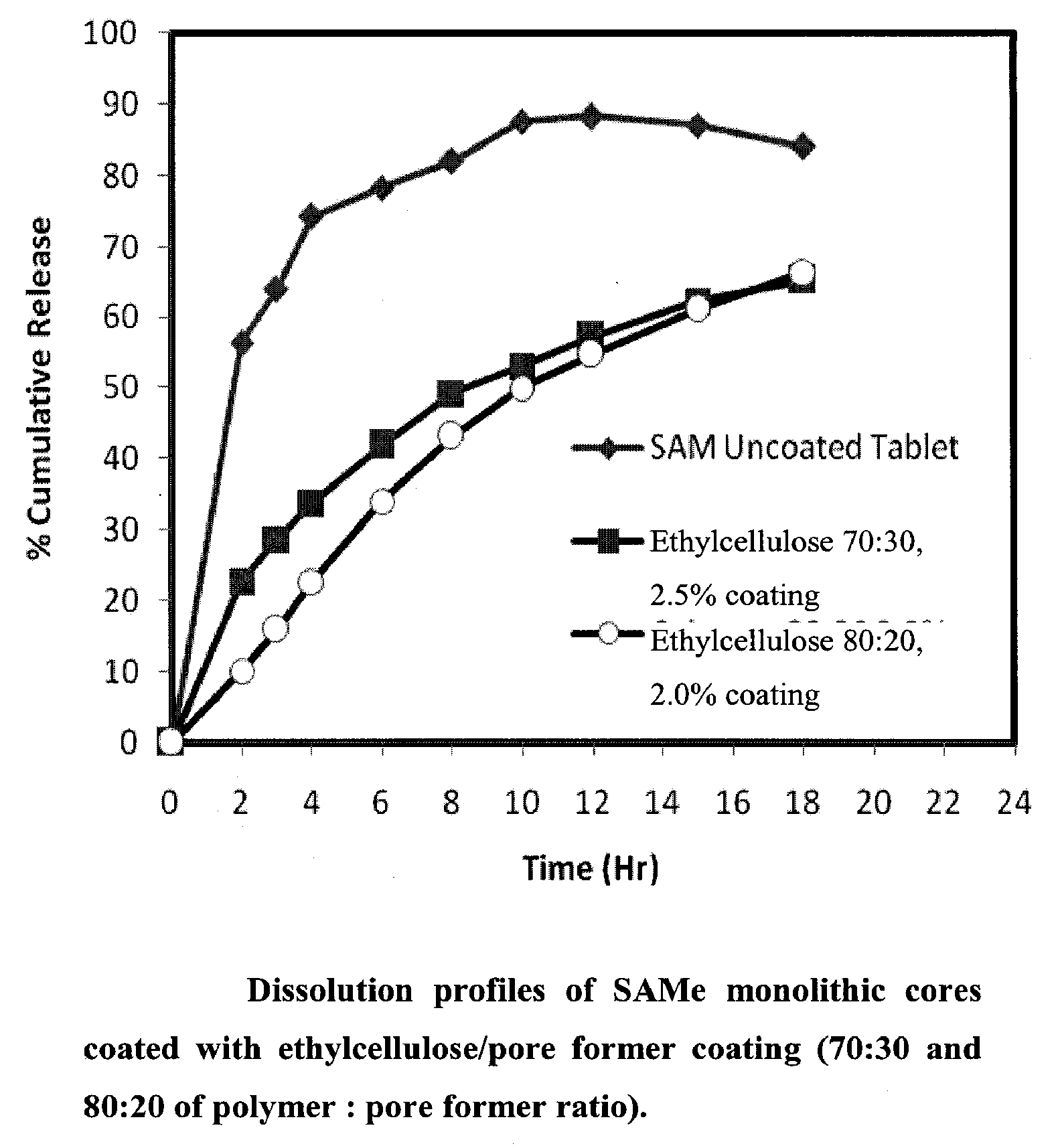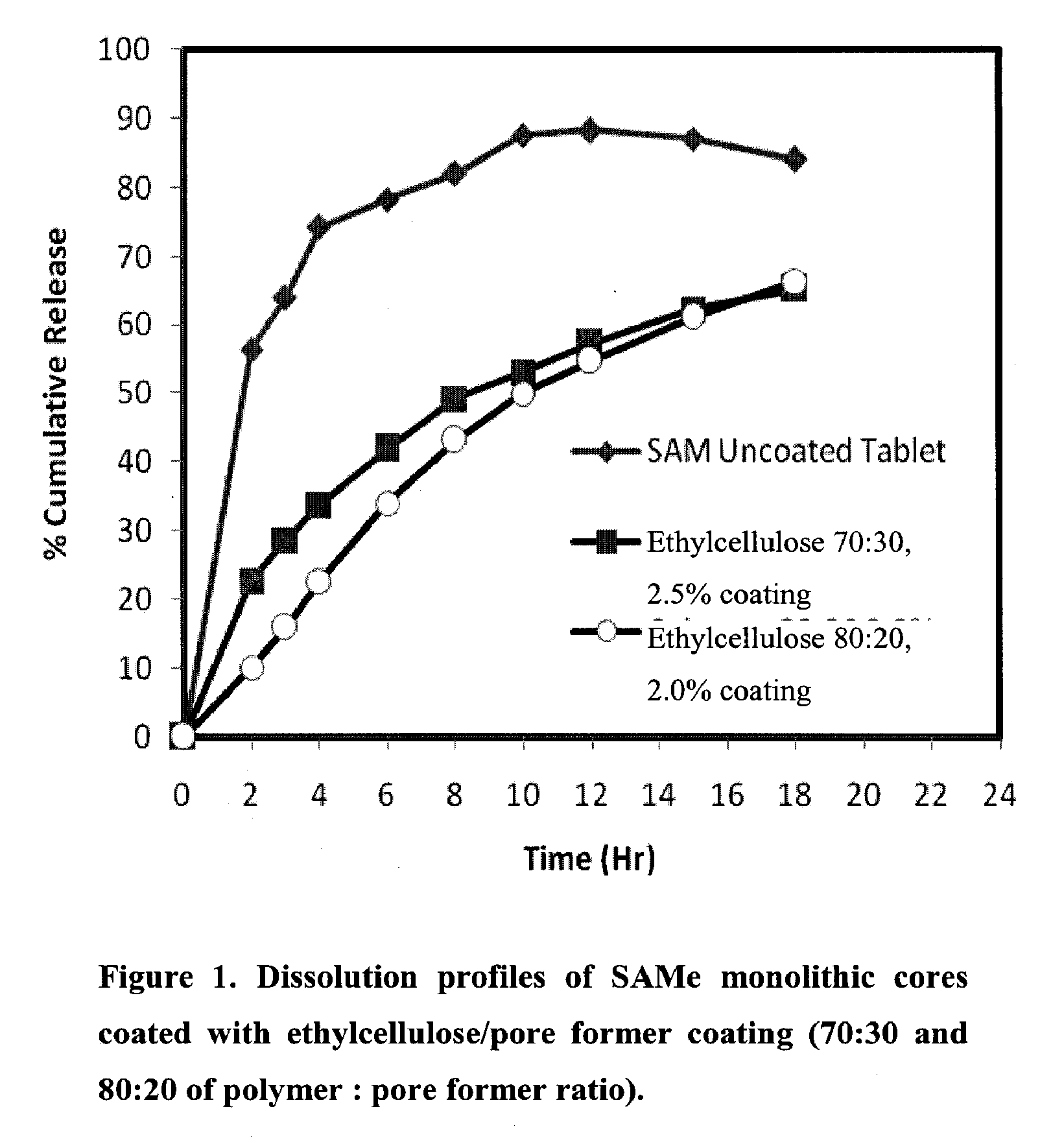Extended Release Pharmaceutical Formulations of S-Adenosylmethionine
a technology of s-adenosylmethionine and extended release, which is applied in the direction of drug composition, biocide, metabolic disorder, etc., can solve the problems of increasing the use of extended release, reducing the biosynthesis of the same supplementation, and initially deemed impractical,
- Summary
- Abstract
- Description
- Claims
- Application Information
AI Technical Summary
Benefits of technology
Problems solved by technology
Method used
Image
Examples
example 1
Extended Release Monolithic Matrix Tablets
[0202]A formulation comprising SAMe, magnesium aluminometasilicate, light liquid paraffin and magnesium stearate was compounded by mixing the ingredients and compressing them with a semi-automatic tablet press. Humidity was maintained at less than 30% and temperature was maintained at 20-25° C. during the entire manufacturing process. The proportions of the ingredients are set forth in Table 1-1, below.
TABLE 1-1Formulation of SAMe with Liquid ParaffinExcipientsMg / Tablet% (wt.)SAMe40072.7%Magnesium Aluminometasilicate (Neusilin US 2)10018.18Light Liquid Paraffin305.45Magnesium Stearate NF203.63Total wt of uncoated tablet (mg)500
[0203]The formulation in Table 1-1 enabled manufacture of SAMe tablets with less than 30% total excipients. The granules used this formulation had good flow properties and demonstrated no sticking picking during compression.
example 2
Slugging Procedure
[0204]In an effort to improve the compressibility of the SAMe formulation from Example 1, a granulation procedure (slugging) was employed. SAMe was mixed with liquid paraffin and magnesium aluminometasilicate. The resulting powder mixture was loaded into a V blender and mixed for 10 minutes at 50 RPM. Half the quantity of magnesium stearate (see Table 2-1, below), 2.97 g, was added to the V blender and mixed for another 10 minutes.
[0205]The resulting powder was passed through a 20 # sieve. The blend was compressed into 400-500 mg slugs with a hardness of about 8-9 kp. The slugs were then milled, passed through a 30 # sieve and mixed with the remaining magnesium stearate (2.97 g). The resulting mixture was then compressed to a hardness of 12-15 kp.
TABLE 2-1Formulation for Manufacturing SAMe Tablet Core with Liquid ParaffinExcipient MassExcipientsMg / Tablet% (wt)for 110 TabletsSAMe80071.8188.00Magnesium aluminometasilicate20017.9522.00Liquid Paraffin6.005.3966.00Magne...
example 3
Coating Trials
[0208]Matrix core SAMe tablets as disclosed in Example 2, above, were coated with ethylcellulose coatings having various amounts of pore former (Nutrateric® pore former, a combination of sodium alginate and purified stearic acid). The ethylcellulose portion of the coating was a combination of purified water, Ethyocel 20 cP STD. Prem. ethylcellulose and 28% ammonium hydroxide. The coatings tested were 100:0 (ethylcellulose:pore former), 80:20 and 70:30 by weight. Tablets were either uncoated or coated with either 2.5% of 70:30 or 80:20 ethylcellulose composition. Dissolution was tested in pH 6.8 PBS buffer solution. The results are summarized in Table 3-1:
TABLE 3-1Dissolution Results for Uncoatedand Coated Tablets at pH 6.8Tablets Coated withTablet Coated withUncoatedEthylcelluloseEthylcelluloseTime (hr)Core70:30*, 2.5%**80:20*, 2.0%**256.3622.7210.17364.0028.7215.99474.2133.7822.73678.2741.9234.09882.0049.1943.221087.5353.1149.951288.2257.3254.681586.9662.2961.151884.0...
PUM
| Property | Measurement | Unit |
|---|---|---|
| pH | aaaaa | aaaaa |
| time | aaaaa | aaaaa |
| time | aaaaa | aaaaa |
Abstract
Description
Claims
Application Information
 Login to View More
Login to View More - R&D
- Intellectual Property
- Life Sciences
- Materials
- Tech Scout
- Unparalleled Data Quality
- Higher Quality Content
- 60% Fewer Hallucinations
Browse by: Latest US Patents, China's latest patents, Technical Efficacy Thesaurus, Application Domain, Technology Topic, Popular Technical Reports.
© 2025 PatSnap. All rights reserved.Legal|Privacy policy|Modern Slavery Act Transparency Statement|Sitemap|About US| Contact US: help@patsnap.com



